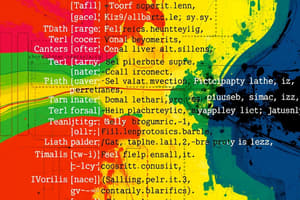Podcast
Questions and Answers
What is the primary purpose of the finite-state machine described for delaying an input string?
What is the primary purpose of the finite-state machine described for delaying an input string?
- To filter out invalid inputs
- To convert binary to decimal
- To produce an output that is the input delayed by one unit of time (correct)
- To recognize patterns in the input
Which output is produced during the initial transition from the start state of the delay machine?
Which output is produced during the initial transition from the start state of the delay machine?
- 0 (correct)
- 1
- The same input bit
- Undefined
What happens to the machine when an input of 0 is received in the error detection machine?
What happens to the machine when an input of 0 is received in the error detection machine?
- It transitions to state s1
- It transitions to state s2
- It remains in the current state
- It transitions to the start state s0 (correct)
In the machine that detects transmission errors with three consecutive 1s, what does state s2 represent?
In the machine that detects transmission errors with three consecutive 1s, what does state s2 represent?
How does the delay machine handle an input of 1 from state s1?
How does the delay machine handle an input of 1 from state s1?
Flashcards are hidden until you start studying
Study Notes
Finite-State Machines with Output
- Finite-state machines (FSMs) are models that represent various technologies in computing, including components found in computers.
- They consist of a finite set of states, an initial state, a designated input alphabet, and a transition function that maps state-input pairs to new states.
- Common applications include spell checking, grammar checking, text indexing/searching, and speech recognition.
Formal Definition
- An FSM with output is defined as M = (S, I, O, f, g, s0), where:
- S: Finite set of states
- I: Finite input alphabet
- O: Finite output alphabet
- f: Transition function defining state transitions
- g: Output function mapping state-input pairs to outputs
- s0: Initial state
Representation of Finite-State Machines
- FSMs can be represented using state tables, showing states, inputs, and associated outputs.
- State diagrams are graphical representations using circles for states and arrows for transitions, labeled with input-output pairs.
Input and Output Relations
- The FSM processes an input string symbol by symbol, transitioning through states based on the transition function.
- Each transition generates an output, leading to an output string that corresponds to the input string through a defined output function.
Examples of Finite-State Machines
-
Unit-Delay Machine:
- Delays the output string by one time unit through three states (s0, s1, s2).
- State s1 remembers if the previous input was 1; s2 remembers if it was 0.
- Outputs 0 for initial transition and reflects the delayed input thereafter.
-
Error Detection Machine:
- Detects three consecutive 1s to indicate a transmission error, reflecting output accordingly.
- Utilizes three states to track sequences of 1s:
- State s0: previous input was not 1.
- State s1: previous input was 1, but not two consecutive 1s.
- State s2: two previous inputs were 1s.
- An input of 0 resets the machine to state s0.
Limitations of Finite-State Machines
- FSMs have limited memory capabilities due to a finite number of states.
- They cannot perform tasks requiring unbounded memory, hindering their effectiveness for certain applications.
Studying That Suits You
Use AI to generate personalized quizzes and flashcards to suit your learning preferences.




